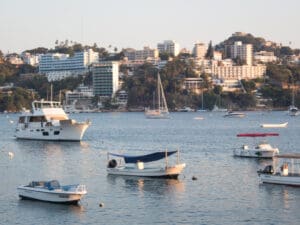
My 45-foot Morgan sloop Tiger Beetle is currently cruising the “gold coast” of Pacific Mexico, Zihuatanejo to Puerto Vallarta, with many interesting and fun small coves and bays along the way to visit. A key item upon arrival is learning what the routines might be and what is going on here — something the cruising guides can’t necessarily provide as the information goes out of date or is not sufficiently detailed. Prior to anchoring I’ll ask around to learn what I can about what’s happening.
The best method I’ve found is to arrive at an anchorage, look for the boat with dinghy attached, suggesting they have not gone ashore, and motor up slowly from astern. When (hopefully) the owners hop up to the cockpit I can talk with them. If I observe another boat pulling into the anchorage I’m always interested in where they are going to set (hopefully not too close to Beetle!); I expect the folks already here are watching my arrival equally closely.
My questions include: How are folks anchored, i.e. bow & stern? bow only? How much scope is out? Is there a recommended dinghy landing? Is there a laundry service available? Are fuel and water available?
In Acapulco the question was which mooring to pick up as none of the moorings are labeled and I wasn’t aware of who to telephone or call on the VHF. I pulled up to the Swiss cruisers on their mooring and asked what they would suggest we do, their response was: “I will telephone Vicente right now, let me tell you after.” And he did so. By the time I’d slowly rounded his bow to return to his boat’s transom he had the response: “Vicente stated to take the square mooring, he will help you in the morning!” I had no idea what a square mooring looked like, perhaps something had gone wrong with the translation from English -> Swiss -> Spanish -> English, but then the fellow mentioned, “We’re leaving in an hour to head south.” I elected to pick up the mooring ball manufactured from a beer keg with a large metal rod through it that appeared the most square one available, then cleaned up Beetle following our five-day passage while waiting for the Swiss folk to depart. They indeed cast off so we shifted over to their mooring. The beer keg looked dodgy but their boat was approximately the length and displacement of Beetle and clearly it had worked for them, so it ought to work for us. In the morning Vicente popped by in his panga and all was fine. We stayed there a week and had good adventures.
After anchoring and launching the dinghy the next big question becomes: Where to land ashore? It’s useful to swing by with the dinghy to visit a boat already settled in to ask after local conditions. Is there a supermarket? Fresh produce? A local cruiser’s radio net? The radio net that is often the most useful as that’s where I can ask the group, “Is there a place to obtain wheel barrow tires for my popped dinghy wheel?” The answer in Zihuatanejo was, “Yes. Go to the Ferreteria del Mar four blocks up from the beach at the pier, they have inner tubes and tires.” Bingo! I visited and indeed they had everything needed (which later expanded to plastic scrapers/putty knives for purposes of barnacle removing).
Cruiser’s nets outside the USA are often held on VHF 22A, a channel reserved for the US Coast Guard in the USA but not used otherwise, which works here as there’s no USCG presence. Internationally VHF 22 is a duplex channel whereas 22A is a simplex channel, which makes it a convenient cruiser’s listening and hailing frequency in Mexico as the locals don’t use it (which keeps the frequency quiet) but the American cruisers are entirely comfortable with it as it’s already programmed into their radios.
As a result of visiting with boats that arrived prior to Beetle were such gems as, “Yes, the fuel station is open tomorrow morning at 7AM”, “dinghy dock is inside on the right, visit the harbor master afterwards, cost is 280 pesos for the day” and “the best dinghy landing is on the beach to the right of the pier. Plan to give the dinghy watchers 20 pesos upon landing – your dinghy will be well-protected.” This is the kind of information you can’t readily obtain from a cruiser’s guide in Pacific Mexico, as the local conditions change so quickly.
The best part? It’s simple to acquire some local knowledge if you’re willing to pull up and ask.
Rob MacFarlane has raced and cruised as a singlehander for 30 years on San Francisco Bay, the West Coast, Hawaii, Mexico, Canada and French Polynesia.

